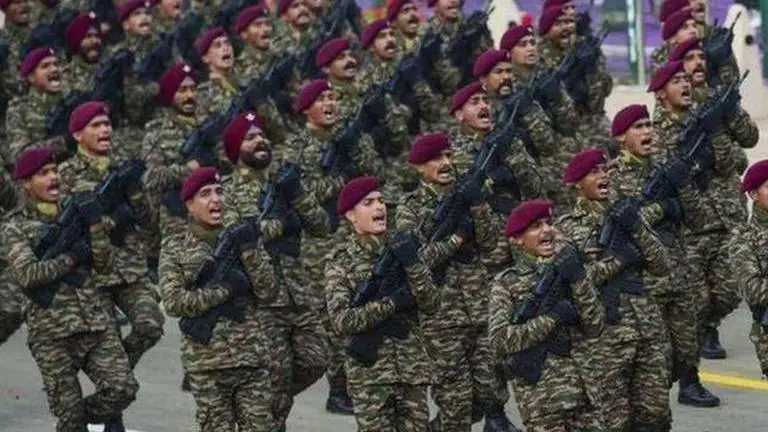Updated 28 May 2023 at 01:07 IST
What transformation has the National Security landscape seen during PM Modi's 9-year rule?
National Security is top priority for Modi Government. This piece analyses the National security of the nation under PM Modi in the last 9 years.
- India News
- 5 min read

The Central Government under PM Modi has asserted the importance of national security from time to time since the Prime Minister took charge of the nation in 2014. This includes threats from outside the nation and threats from within as well. This reflects well in the Independence Day address of Prime Minister in 2021 as he stated, “Today the world is looking at India from a new perspective. There are two important aspects of this perception -- one is terrorism and the other is expansionism. India is fighting both these challenges and is also responding strongly in a restrained manner. Our defence preparedness has to be equally strong if India has to fulfil its obligations properly..”
The Narendra Modi government has shown its capabilities in various areas ranging from women empowerment, farmer centric policies, economic inclusion, foreign policy and national security among others. The appointment of the right people at the right place majorly helped the government in achieving historic feats. And a water-tight National Security has been shaped after the appointment of the veteran-spy NSA Ajit Doval. The National Security Advisor to the Prime Minister, Ajit Doval, who played a key role during the Nuclear Deal with the USA was handpicked by the PM for this role.
PM Modi also stated this in his speech in the past, “We have not shied away from taking decisions that are tough. For us, the nation is bigger than politics.”
Some important steps by the Central government to ensure India’s heightened security are listed below-
Scrapping of Article 370:
Removal of Article 370 truly integrated Jammu & Kashmir with the rest of India, bringing the dream of One Nation - One Constitution to life. This also helped in bringing terrorism down in the UT of J&K. In J&K, terrorist incidents have decreased by 54%, while security force fatalities have decreased by 84%. As a result, many troubled areas are now emerging as hotspots of development and economic growth.
Indigenous Defence industry:
The former CDS of India, Late Bipin Rawat, truly remarked that, “We must win the next war with home-made solutions.” With this statement, he made it clear that India cannot depend on foreign players for its security needs. The Central Government has ensured this by boosting the development of indigenous defence industry in a bid to achieve the goal of Aatmanirbhar Bharat. The Army, Air Force, and our Naval Forces now have more precise fighting capability because of nine years of unmatched military modernisation. Along with this, the indigenisation of 2,786 defence products is a significant step towards becoming Aatmanirbhar in Defence. With almost 13,525 km of new border highways built in the previous five years alone, security logistics have been strengthened by unprecedented border infrastructure development. India's defence output for the first time ever surpassed the Rs 1 lakh crore mark as a result of governmental changes to support the defence industry. As a result, India now exports defence products to 85 countries across the world.
Advertisement
Peace agreements with insurgent groups:
The eight states that make up the NorthEast region of India—Assam, Arunachal Pradesh, Manipur, Meghalaya, Mizoram, Nagaland, Sikkim, and Tripura—have their own unique histories and identities. The region, which borders Bhutan, China, Myanmar, and Bangladesh, has a reputation for being one of India's most sensitive areas. This region's history has been tainted by insurgency and underdevelopment since 1947.
Under PM Modi's administration, the central government has been working nonstop to put an end to insurgency and violence in the region. The major agreements which played an important role in bringing peace in the north-east are Naga peace accord, Bodo Accord, Bru-Reang Agreement, National Liberation Front of Tripura (NLFT) Agreement, Karbi Anglong Agreement, Assam-Meghalaya Inter-State Boundary Agreement.
Advertisement
The status of AFSPA in the northeastern states shows us the security status of the region:
- Assam: AFSPA removed from 60% of Assam
- Nagaland: 15 police stations in seven districts removed from disturbed area periphery
- Manipur: Disturbed area status revoked from 15 police stations in six districts
- Arunachal Pradesh: Only three districts are under AFSPA now
- Meghalaya and Tripura: AFSPA is completely withdrawn from these two states
Curbing of LWE and Maoist threat
Due to the efforts of the central government, the maoist extremism has decreased by 53-55%. The geographical region affected by Left-wing extremism has been reduced by 40-45%. Since 2015, less districts have been affected by Maoist violence, according to data, with more than 90% of attacks coming from Bihar, Chhattisgarh, Jharkhand, and Odisha. In 2015, violent Naxal attacks were reported in 75 districts across nine states; this number decreased to 67 in 2016 and to 58 in 2017.
The number of districts affected by left-wing extremist violence has decreased to 58 due to a revised counter-insurgency strategy that targets Maoists deep inside the jungles using modern technology like drones and coordinated day and night operations by security personnel.
India’s holistic approach regarding its national security has aided in the development and growth of the nation which in turn gives the country a leverage to take a steadfast approach in modernising its military and police forces.
Published By : Piyush Gupta
Published On: 28 May 2023 at 01:07 IST
